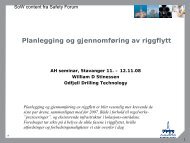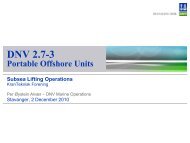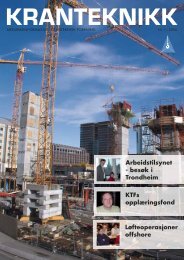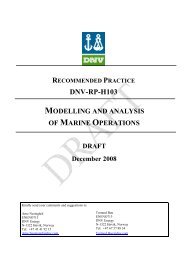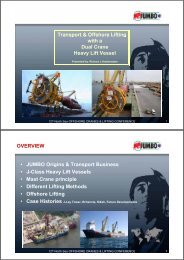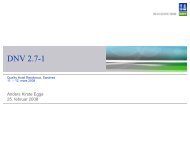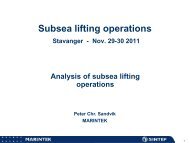DNV Marine Operations' Rules for Subsea Lift Operations
DNV Marine Operations' Rules for Subsea Lift Operations
DNV Marine Operations' Rules for Subsea Lift Operations
You also want an ePaper? Increase the reach of your titles
YUMPU automatically turns print PDFs into web optimized ePapers that Google loves.
<strong>DNV</strong> <strong>Marine</strong> <strong>Operations</strong>’ <strong>Rules</strong><strong>for</strong> <strong>Subsea</strong> <strong>Lift</strong> <strong>Operations</strong>New Simplified Method <strong>for</strong> Prediction of Hydrodynamic ForcesTormod Bøe<strong>DNV</strong> <strong>Marine</strong> <strong>Operations</strong>2nd December 2009
Content• Brief overview of relevant <strong>DNV</strong> publications• <strong>DNV</strong> <strong>Rules</strong> <strong>for</strong> <strong>Marine</strong> <strong>Operations</strong>, 1996,Pt.2 Ch.5 <strong>Lift</strong>ing – Capacity Checks• New Simplified Method <strong>for</strong> calculation ofhydrodynamic <strong>for</strong>ces, <strong>DNV</strong>-RP-H103 Ch.4• CFD Analyses – Test Cases<strong>DNV</strong> <strong>Marine</strong> <strong><strong>Operations</strong>'</strong> <strong>Rules</strong> <strong>for</strong> <strong>Subsea</strong> <strong>Lift</strong> <strong>Operations</strong> 2 December 2009Slide 2
Relevant <strong>DNV</strong> Publications<strong>Lift</strong>ing- and subsea operations :<strong>DNV</strong> <strong>Rules</strong> <strong>for</strong> Planning and Execution of<strong>Marine</strong> <strong>Operations</strong> – 1996’Special planned, non-routine operations oflimited durations, at sea. <strong>Marine</strong> operations arenormally related to temporary phases as e.g.load transfer, transportation and installation.’<strong>DNV</strong>-OS-E402Offshore Standard <strong>for</strong> DivingSystems January 2004(Amendments October 2009)<strong>DNV</strong> Standard <strong>for</strong> CertificationNo.2.22 <strong>Lift</strong>ing AppliancesOctober 2008<strong>DNV</strong> Standard <strong>for</strong> CertificationNo. 2.7-1 Offshore ContainersApril 2006Special planned non-routine operationsRoutine operations<strong>DNV</strong> <strong>Marine</strong> <strong><strong>Operations</strong>'</strong> <strong>Rules</strong> <strong>for</strong> <strong>Subsea</strong> <strong>Lift</strong> <strong>Operations</strong> 2 December 2009Slide 3
Relevant <strong>DNV</strong> Publications - Other• <strong>DNV</strong>-RP-C205 Environmental Conditions andEnvironmental Loads April 2007• <strong>DNV</strong>-RP-H101 Risk Management in <strong>Marine</strong> and<strong>Subsea</strong> <strong>Operations</strong>, January 2003• <strong>DNV</strong>-RP-H102 <strong>Marine</strong> <strong>Operations</strong> during Removal ofOffshore Installations, April 2004• <strong>DNV</strong>-RP-H103 Modelling and Analysis of <strong>Marine</strong><strong>Operations</strong>, April 2009• Standard <strong>for</strong> Certification No. 2.7-3 Portable OffshoreUnits, June 2006 (a new revision will be issued 2010which will include subsea units)• <strong>DNV</strong>-OS-J-101 and -201 Design of Offshore WindTurbine Structures and Substations <strong>for</strong> Wind Farms,October 2007 / 2009• <strong>DNV</strong>-OS-E303 and -RP-E304 Offshore Mooring FibreRopes, Certification (2008) and Damage Assessment (2005)<strong>DNV</strong> <strong>Marine</strong> <strong><strong>Operations</strong>'</strong> <strong>Rules</strong> <strong>for</strong> <strong>Subsea</strong> <strong>Lift</strong> <strong>Operations</strong> 2 December 2009Slide 4
Relevant <strong>DNV</strong> Publications - Purchase<strong>DNV</strong> publications can be purchased at:http://webshop.dnv.com/global/<strong>DNV</strong> <strong>Marine</strong> <strong><strong>Operations</strong>'</strong> <strong>Rules</strong> <strong>for</strong> <strong>Subsea</strong> <strong>Lift</strong> <strong>Operations</strong> 2 December 2009Slide 5
Content• Brief overview of relevant <strong>DNV</strong>publications• <strong>DNV</strong> <strong>Rules</strong> <strong>for</strong> <strong>Marine</strong> <strong>Operations</strong>, 1996,<strong>Lift</strong>ing – Capacity Checks• New Simplified Method <strong>for</strong> calculation ofhydrodynamic <strong>for</strong>ces• CFD Analyses – Test Cases<strong>DNV</strong> <strong>Marine</strong> <strong><strong>Operations</strong>'</strong> <strong>Rules</strong> <strong>for</strong> <strong>Subsea</strong> <strong>Lift</strong> <strong>Operations</strong> 2 December 2009Slide 6
Capacity Checks - <strong>DNV</strong> 1996 <strong>Rules</strong>Part 2 Chapter 5• Dynamic loads, lift in air• Crane capacity• Rigging capacity,(slings, shackles, etc.)• Structural steel capacity(lifted object, lifting points,spreader bars, etc.)Part 2 Chapter 6• Dynamic loads, subsea lifts(capacity checks as in Chapter 5 applying dynamic loads from Chapter 6)<strong>DNV</strong> <strong>Marine</strong> <strong><strong>Operations</strong>'</strong> <strong>Rules</strong> <strong>for</strong> <strong>Subsea</strong> <strong>Lift</strong> <strong>Operations</strong> 2 December 2009Slide 8
Capacity Checks - Crane CapacityThe dynamic hook load, DHL, isgiven by:DHL = DAF*(W+Wrig) + F(SPL)ref. Pt.2 Ch.5 Sec.2.4.2.1• W is the weight of the structure,including a weight inaccuracy factor• The DHL should be checked againstavailable crane capacity• The crane capacity decrease whenthe lifting radius increase.<strong>DNV</strong> <strong>Marine</strong> <strong><strong>Operations</strong>'</strong> <strong>Rules</strong> <strong>for</strong> <strong>Subsea</strong> <strong>Lift</strong> <strong>Operations</strong> 2 December 2009Slide 10
Capacity Checks - Sling LoadsThe maximum dynamic sling load, Fsling,can be calculated by:Example :Fsling = DHL·SKL·kCoG·DW / sin φref. Pt.2 Ch.5 Sec.2.4.2.3-6where:• SKL = Skew load factor → extra loadingcaused by equipment and fabrication tolerances.• kCoG = CoG factor → inaccuracies in estimatedposition of centre of gravity.• DW = vertical weight distribution → e.g.DWA = (8/15)·(7/13) in sling A.• φ = sling angle from the horizontal plane.<strong>DNV</strong> <strong>Marine</strong> <strong><strong>Operations</strong>'</strong> <strong>Rules</strong> <strong>for</strong> <strong>Subsea</strong> <strong>Lift</strong> <strong>Operations</strong> 2 December 2009Slide 11
Capacity Checks - Slings and ShacklesThe sling capacity ”Minimum breaking load”,MBL, is checked by:F
Capacity Checks – Structural Steel<strong>Lift</strong>ing points:The load factor γ f = 1.3, is increased by aconsequence factor, γ C = 1.3, so that totaldesign faktor, γdesign , becomes:γdesign = γc· γf = 1.3 · 1.3 = 1.7The design load acting on the lift point becomes:Other lifting equipment:A consequence factor of γ C = 1.3should be applied on lifting yokes,spreader bars, plateshackles, etc.Structural strength of <strong>Lift</strong>ed Object:The following consequence factorsshould be applied :Fdesign = γdesign· Fsling = 1.7· FslingA lateral load ofminimum 3% of thedesign load shall beincluded. This loadacts in the shacklebow !(ref. Pt.2.Ch.5 Sec.2.4.3.4)Table 4.1 Pt.2 Ch.5 Sec.4.1.2<strong>DNV</strong> <strong>Marine</strong> <strong><strong>Operations</strong>'</strong> <strong>Rules</strong> <strong>for</strong> <strong>Subsea</strong> <strong>Lift</strong> <strong>Operations</strong> 2 December 2009Slide 13
New Simplified Method - AssumptionsThe Simplified Method is based upon thefollowing main assumptions:• the horizontal extent of the lifted object issmall compared to the wave length• the vertical motion of the object is equal thevertical crane tip motion• vertical motion of object and water dominates→ other motions can be disregardedThe intention of the Simplified Method is togive simple conservative estimates of the<strong>for</strong>ces acting on the object.<strong>DNV</strong> <strong>Marine</strong> <strong><strong>Operations</strong>'</strong> <strong>Rules</strong> <strong>for</strong> <strong>Subsea</strong> <strong>Lift</strong> <strong>Operations</strong> 2 December 2009Slide 16
New Simplified Method - AssumptionsTime-domain analysis:Includes loads and motionresponses on both installationvessel and lifted object.<strong>Lift</strong>ed object modelledapplying correct geometry(not just a point in space) simulation valid <strong>for</strong> all wavelengths.Cranewire, lifting slings andtugger lines are included motion response of the liftedobject is computed resonance effects arecovered in analysis.Statistical analysis ofresponses in irregular seastates included.Coupling effects included(crane tip motions may beinfluenced by lifted structure).Non-linear response, as e.g.snap loads in lifting slings,can be computed.Visualization of lift.<strong>DNV</strong> <strong>Marine</strong> <strong><strong>Operations</strong>'</strong> <strong>Rules</strong> <strong>for</strong> <strong>Subsea</strong> <strong>Lift</strong> <strong>Operations</strong> 2 December 2009Slide 17
New Simplified Method – Crane Tip Motions• The Simplified Method is unapplicable if the crane tiposcillation period or the wave period is close to theresonance period, Tn , of the hoisting systemM+KAT33n = 2π• Heave, pitch and roll RAOs <strong>for</strong>the vessel should be combinedwith crane tip position to findthe vertical motion of the crane tip• If operation reference period iswithin 30 minutes, the mostprobable largest responses maybe taken as 1.80 times thesignificant responses• If the vessel heading is not fixed,vessel response should beanalysed <strong>for</strong> wave directions atleast ±15° off the applied vesselheading<strong>DNV</strong> <strong>Marine</strong> <strong><strong>Operations</strong>'</strong> <strong>Rules</strong> <strong>for</strong> <strong>Subsea</strong> <strong>Lift</strong> <strong>Operations</strong> 2 December 2009Slide 18
New Simplified Method – Wave PeriodsThere are two alternative approaches:Alt-1) Wave periods are included:Analyses should cover the following zerocrossingwave period range:H s8.9⋅ ≤ Tz≤g13A lower limit of Hmax=1.8·Hs=λ/7 withwavelength λ=g·T z 2 /2π is here used.Alt-2) Wave periods are disregarded:Operation procedures should in this case reflect that the calculations are only valid <strong>for</strong>waves longer than:Tz≥ 10 . 6⋅HgSA lower limit of Hmax=1.8·Hs=λ/10 with wavelengthλ=g·T z 2 /2π is here used.<strong>DNV</strong> <strong>Marine</strong> <strong><strong>Operations</strong>'</strong> <strong>Rules</strong> <strong>for</strong> <strong>Subsea</strong> <strong>Lift</strong> <strong>Operations</strong> 2 December 2009Slide 19
New Simplified Method – Wave KinematicsAlt-1) Wave periods are included:The wave amplitude, wave particlevelocity and acceleration can be taken as:ζ• aH Sv• wa• w= 0. 9 ⋅= ζ= ζaa⎛ 2π⎞⋅⎜⎟eT⋅⎝ z ⎠⎛ 2π⎞⋅ ⎜ ⎟T⎝ z ⎠2⋅−e4π2d−T2zTg4π2d2zg• d :distance from water plane to CoG ofsubmerged part of objectAlt-2) Wave periods are disregarded:The wave particle velocity and acceleration canbe taken as:v• wa• w= 0.30 π g Hs= 0.10πg ⋅e−⋅e0.35dHs−0.35dHs<strong>DNV</strong> <strong>Marine</strong> <strong><strong>Operations</strong>'</strong> <strong>Rules</strong> <strong>for</strong> <strong>Subsea</strong> <strong>Lift</strong> <strong>Operations</strong> 2 December 2009Slide 20
New Simplified Method – Hydrodynamic ForcesSlamming impact <strong>for</strong>ceSlamming <strong>for</strong>ces are short-term impulse<strong>for</strong>ces that acts when the structure hits thewater surface.A S is the relevant slamming area on theexposed structure part. Cs is slamming coeff.The slamming velocity, v s , is :v = v + v +sc2ctv2w• vc = lowering speed• vct = vertical crane tip velocity• vw = vertical water particle velocityat water surfaceVarying buoyancy <strong>for</strong>ceVarying buoyancy, Fρ , is the change inbuoyancy due to the water surface elevation.Fρ= ρ ⋅δV⋅ gδV is the change in volume of displacedwater from still water surface to wavecrest or wave trough.Fρ= ρ ⋅δV⋅ g~δ V = ⋅ ζ + ηA w2a2ct• ζa = wave amplitude• ηct = crane tip motion amplitude• Ãw = mean water line area in thewave surface zone<strong>DNV</strong> <strong>Marine</strong> <strong><strong>Operations</strong>'</strong> <strong>Rules</strong> <strong>for</strong> <strong>Subsea</strong> <strong>Lift</strong> <strong>Operations</strong> 2 December 2009Slide 21
New Simplified Method – Hydrodynamic ForcesDrag <strong>for</strong>ceDrag <strong>for</strong>ces are flow resistance onsubmerged part of the structure. The drag<strong>for</strong>ces are related to relative velocity betweenobject and water particles.The drag coefficient, CD, in oscillatory flow <strong>for</strong>complex subsea structures may typically beCD ≥ 2.5.Relative velocity are found by :v = v + v +rc2ctv2w• vc = lowering/hoisting speed• vct = vertical crane tip velocity• vw = vertical water particle velocityat water depth , d• Ap = horizontal projected areaMass <strong>for</strong>ce“Mass <strong>for</strong>ce” is here a combination of inertia<strong>for</strong>ce, Froude-Kriloff <strong>for</strong>ce and diffraction<strong>for</strong>ce.Crane tip acceleration and water particleacceleration are assumed statisticallyindependent.FM2[( M + A ) ⋅a] + [( V + A ) ⋅a] 2= ρ33 ct33 w• M = mass of object in air• A33 = heave added mass of object• act = vertical crane tip acceleration• V = volume of displaced water relative tothe still water level• aw = vertical water particle accelerationat water depth, d<strong>DNV</strong> <strong>Marine</strong> <strong><strong>Operations</strong>'</strong> <strong>Rules</strong> <strong>for</strong> <strong>Subsea</strong> <strong>Lift</strong> <strong>Operations</strong> 2 December 2009Slide 22
New Simplified Method – Hydrodynamic ForceThe hydrodynamic <strong>for</strong>ce is a time dependent function of slamming impact<strong>for</strong>ce, varying buoyancy, hydrodynamic mass <strong>for</strong>ces and drag <strong>for</strong>ces. In theSimplified Method the <strong>for</strong>ces may be combined as follows:F22hyd = ( FD+ Fslam) + ( FM− Fρ)• The structure may be divided intomain items and surfaces contributingto the hydrodynamic <strong>for</strong>ce• Water particle velocity andacceleration are related to thevertical centre of gravity <strong>for</strong> eachmain item. Mass and drag <strong>for</strong>cescontributions are then summarized :FM = ∑F M iiF D = ∑F DiiFMi and FDi are the individual<strong>for</strong>ce contributions from eachmain item<strong>DNV</strong> <strong>Marine</strong> <strong><strong>Operations</strong>'</strong> <strong>Rules</strong> <strong>for</strong> <strong>Subsea</strong> <strong>Lift</strong> <strong>Operations</strong> 2 December 2009Slide 23
New Simplified Method – Load Cases ExampleThe static and hydrodynamic <strong>for</strong>ce should be calculated <strong>for</strong> different stages. Relevantload cases <strong>for</strong> deployment of a protection structure could be:Load Case 1Still water level beneath top of ventilated buckets• Slamming impact <strong>for</strong>ce, Fslam, acts on top ofbuckets.• Varying buoyancy <strong>for</strong>ce, Fρ , drag <strong>for</strong>ce, FDand mass <strong>for</strong>ce, FM are negligible.Load Case 2Still water level above top of buckets• Slamming impact <strong>for</strong>ce, Fslam, is zero• Varying buoyancy, Fρ , drag <strong>for</strong>ce, FD andmass <strong>for</strong>ce, FM, are calculated. Velocity andacceleration are related to CoG of submergedpart of structure.<strong>DNV</strong> <strong>Marine</strong> <strong><strong>Operations</strong>'</strong> <strong>Rules</strong> <strong>for</strong> <strong>Subsea</strong> <strong>Lift</strong> <strong>Operations</strong> 2 December 2009Slide 24
New Simplified Method – Load Cases ExampleLoad Case 3Still water level beneath roof cover.• Slamming impact <strong>for</strong>ce, Fslam, acts on the roofcover.• Varying buoyancy, Fρ , drag <strong>for</strong>ce, FD and mass<strong>for</strong>ce, FM are calculated on the rest of thestructure. Drag- and mass <strong>for</strong>ces acts mainly onthe buckets and is related to a depth, d, down toCoG of submerged part of the structure.Load Case 4Still water level above roof cover.• Slamming impact <strong>for</strong>ce, Fslam, and varyingbuoyancy, Fρ, is zero.• Drag <strong>for</strong>ce, FD and mass <strong>for</strong>ce, FM are calculatedindividually. The total mass and drag <strong>for</strong>ce is thesum of the individual load components, e.g. :FD= F Droof + F Dlegs + F Dbuckets applying correct CoGs<strong>DNV</strong> <strong>Marine</strong> <strong><strong>Operations</strong>'</strong> <strong>Rules</strong> <strong>for</strong> <strong>Subsea</strong> <strong>Lift</strong> <strong>Operations</strong> 2 December 2009Slide 25
New Simplified Method – Load Cases Example<strong>DNV</strong> <strong>Marine</strong> <strong><strong>Operations</strong>'</strong> <strong>Rules</strong> <strong>for</strong> <strong>Subsea</strong> <strong>Lift</strong> <strong>Operations</strong> 2 December 2009Slide 26
New Simplified Method – Static Weight• In addition, the weight inaccuracy factor should be applied<strong>DNV</strong> <strong>Marine</strong> <strong><strong>Operations</strong>'</strong> <strong>Rules</strong> <strong>for</strong> <strong>Subsea</strong> <strong>Lift</strong> <strong>Operations</strong> 2 December 2009Slide 27
New Simplified Method - DAFCapacity ChecksThe capacities of crane, lifting equipment andlifted object are checked as <strong>for</strong> lift in air. Thefollowing relation should be applied:DAF=FtotalMgwhereMg : weight of object in air [N]Ftotal : is the characteristic total <strong>for</strong>ce on the(partly or fully) submerged object. Taken as thelargest of;Ftotal = Fstatic-max + FhydFtotal = Fstatic-max + Fsnapor• Fstatic-max is the maximum staticweight of the submerged objectincluding flooding and weightinaccuracy factor• Fhyd is the hydrodynamic <strong>for</strong>ce• Fsnap is the snap load (normallyto be avoided)<strong>DNV</strong> <strong>Marine</strong> <strong><strong>Operations</strong>'</strong> <strong>Rules</strong> <strong>for</strong> <strong>Subsea</strong> <strong>Lift</strong> <strong>Operations</strong> 2 December 2009Slide 28
New Simplified Method – Slack SlingsThe Slack Sling Criterion.• Snap <strong>for</strong>ces shall as far as possiblebe avoided. Weather crietria shouldbe adjusted to ensure this.• The following criterion should befulfilled in order to ensure that snaploads are avoided:F≤0.9 ⋅hyd F static −min• Fstatic-min = weight be<strong>for</strong>e flooding,including a weight reduction impliedby the weight inaccuracy factor.<strong>DNV</strong> <strong>Marine</strong> <strong><strong>Operations</strong>'</strong> <strong>Rules</strong> <strong>for</strong> <strong>Subsea</strong> <strong>Lift</strong> <strong>Operations</strong> 2 December 2009Slide 29
New Simplified Method – Added MassHydrodynamic added mass <strong>for</strong> flat platesExample:Flat plate wherelength, b, abovebreadth, a, isb/a = 2.0 :π 2A33 = ρ ⋅0.76⋅ ⋅a⋅b4<strong>DNV</strong> <strong>Marine</strong> <strong><strong>Operations</strong>'</strong> <strong>Rules</strong> <strong>for</strong> <strong>Subsea</strong> <strong>Lift</strong> <strong>Operations</strong> 2 December 2009Slide 30
New Simplified Method – Added MassAdded Mass Increase due to Body HeightAdded Mass Increase due to Body HeightThe following simplified approximation of theadded mass in heave <strong>for</strong> a three-dimensionalbody with vertical sides may be applied :⎡2 ⎤1A ⎢ − λ33 ≈ 1 +⎥ ⋅ A⎢2 33o2(1 )⎥⎢+ λ⎣⎥⎦andλ =h +ApApA33/A33o1.81.71.61.51.41.31.21.111+SQRT((1-lambda^2)/(2*(1+lambda^2)))0 0.5 1 1.5 2 2.5ln [ 1+ (h/sqrt(A)) ]where• A33o = added mass <strong>for</strong> a flat plate with ashape equal to the horizontal projectedarea of the object• h = height of the object• Ap = horizontal projected area of the object<strong>DNV</strong> <strong>Marine</strong> <strong><strong>Operations</strong>'</strong> <strong>Rules</strong> <strong>for</strong> <strong>Subsea</strong> <strong>Lift</strong> <strong>Operations</strong> 2 December 2009Slide 31
New Simplified Method – Added MassAdded Mass from Partly Enclosed VolumeA volume of water partlyenlosed within large platedsurfaces will also contributeto the added mass, e.g.:• The volume of waterinside suction anchorsor foundation buckets.• The volume of waterbetween large platedmudmat surfaces androof structures.<strong>DNV</strong> <strong>Marine</strong> <strong><strong>Operations</strong>'</strong> <strong>Rules</strong> <strong>for</strong> <strong>Subsea</strong> <strong>Lift</strong> <strong>Operations</strong> 2 December 2009Slide 32
New Simplified Method – Example CaseExample: Submerged Foundation Bucket• Added mass <strong>for</strong> a thin circular disc:2 4 3A33 o = ρ ⋅ ⋅ ⋅π⋅ 2.0 = 21867 kgπ 3• Added mass increase due to body height:π ⋅ 2.0λ =3.5 + π ⋅ 2.022= 0.50 ⇒A'33s⎡= ⎢1+⎢⎣2 ⋅1−0.5022( 1+0.50 )⎤⎥ ⋅ A⎥⎦33o= 33803 kg2 4 3Flat plate: A33o= ρ ⋅ ⋅ ⋅π⋅ 2.0 = 21867 kgπ 32π ⋅ 2.0Height factor : λ =21+π ⋅ 2.0⎡'Height increase: A33s= ⎢1+⎢⎢⎣Incl.inside volume:2π ⋅0.4Per<strong>for</strong>ation : P = 100 ⋅ = 42π ⋅ 2.021−0.782 ⋅= 0.782( 1 + 0.78 )⎤⎥ ⋅ A33o= 29496 kg⎥⎦⎥2A33s= 29496 + π ⋅1.75⋅3.25⋅ ρ = 61546 kg< 8 ⇒ No reduction of A33s• Added mass including partly enclosed volume:A33 s = 33803 + π ⋅1.75⋅3.25⋅ ρ =265854 kg• Added mass reduction due to per<strong>for</strong>ation:2π ⋅0.4P = 100⋅2π ⋅2.0= 4 ≈ SMALL ⇒ No reduction ofA33sBucket Dimensions:• Height = 3.5m• Diameter = 4.0m• Plate thickness = 0.25m• Ventilation hole diameter = 0.8m<strong>DNV</strong> <strong>Marine</strong> <strong><strong>Operations</strong>'</strong> <strong>Rules</strong> <strong>for</strong> <strong>Subsea</strong> <strong>Lift</strong> <strong>Operations</strong> 2 December 2009Slide 34
New Simplified Method – Example CaseExample: Submerged Foundation Bucket1.0m• Water particle velocity and acceleration:24π⋅(1+1.25)⎛ 2π⎞−222v 1.75 e 5.5 9.81⎛ ⎞w = ⋅⎜⎟⋅ ⋅π= 1.48m/s and aw= ⎜ ⎟⋅vw= 1. 69 m/s⎝ 5.5 ⎠⎝ 5.5 ⎠CoG1.25m• Drag <strong>for</strong>ce:F( 0.25 + 1.48) 2 = 0.37 ⋅5 ND = 0.5 ⋅ ρ ⋅CD⋅ AP⋅ vr2 = 0.5 ⋅ ρ ⋅ 2.0 ⋅0.96π 2.02 ⋅10• Mass <strong>for</strong>ce:2[( M + A ) ⋅ a ] + [( V + A ) ⋅ a ] 2 = ( 13031 + 65854 ) ⋅1.69= 1.33 ⋅5 NFM = ρ1033• Hydrodynamic <strong>for</strong>ce:Fct33w225 25 2( F + F ) + ( F − F ) = ( 0.37 ⋅10) + ( 1.33 ⋅10) = 1.4 ⋅5 Nhyd = D slam M ρ10Regular Wave Data:• Wave Height, H max = 3.5m• Wave Period, T z = 5.5sOther Data• Buoyancy, ρV = 13031kg• Negligible crane tip motions• Lowering speed = 0.25m/s<strong>DNV</strong> <strong>Marine</strong> <strong><strong>Operations</strong>'</strong> <strong>Rules</strong> <strong>for</strong> <strong>Subsea</strong> <strong>Lift</strong> <strong>Operations</strong> 2 December 2009Slide 35
Content• Brief overview of relevant <strong>DNV</strong>publications• <strong>DNV</strong> <strong>Rules</strong> <strong>for</strong> <strong>Marine</strong> <strong>Operations</strong>, 1996,<strong>Lift</strong>ing – Capacity Checks• New Simplified Method <strong>for</strong> calculation ofhydrodynamic <strong>for</strong>ces• CFD Analyses – Test Cases<strong>DNV</strong> <strong>Marine</strong> <strong><strong>Operations</strong>'</strong> <strong>Rules</strong> <strong>for</strong> <strong>Subsea</strong> <strong>Lift</strong> <strong>Operations</strong> 2 December 2009Slide 36
CFD Analyses – Test Cases• Computational Fluid Dynamics(CFD) is a numerical method <strong>for</strong>computing fluid flows based onthe Navier Stokes equations.Structure• The CFD-program COMFLOW isable to study complex freesurface problems applying theVolume of Fluid method.• The fluid domain consists of acartesian grid where the fluidcells are defined either asboundary cells, empty cells,surface cells or fluid cells.• Pressure <strong>for</strong>ces are calculatedas the integral of the pressurealong the boundary of an object.• Motion responses are notincluded, but the object can begiven a prescribed motion.Inflow boundary,Airy or Stokes5 th waveFluiddomainNumericalbeach ataft end<strong>DNV</strong> <strong>Marine</strong> <strong><strong>Operations</strong>'</strong> <strong>Rules</strong> <strong>for</strong> <strong>Subsea</strong> <strong>Lift</strong> <strong>Operations</strong> 2 December 2009Slide 37
CFD Analyses – Protection StructureCFD analysis:Regular Stokes 5thwave: H=3.5m T=5.5sDomain 95x30x37m4.4 million fluid cellsMinimum grid size0.18m near object,stretched elsewhere8.5x8.5m solid roofand 10x10xØ1.0m topframeØ1.0m legs, height 8mand hollow3.5xØ4.0m buckets atx,y=±8.5mventilation holesØ0.8mWall thickness 0.25mhalf model60s simulation time<strong>DNV</strong> <strong>Marine</strong> <strong><strong>Operations</strong>'</strong> <strong>Rules</strong> <strong>for</strong> <strong>Subsea</strong> <strong>Lift</strong> <strong>Operations</strong> 2 December 2009Slide 38
CFD Analyses – Protection StructureF hyd ≈ 1.1·10 5 NHighest upwardshydrodynamic <strong>for</strong>cewhen bucket is fullysubmerged occurswhen the object islocated in a wavetrough.Buoyancy, ρVg<strong>DNV</strong> <strong>Marine</strong> <strong><strong>Operations</strong>'</strong> <strong>Rules</strong> <strong>for</strong> <strong>Subsea</strong> <strong>Lift</strong> <strong>Operations</strong> 2 December 2009Slide 39
CFD Analyses – Protection StructureHalf wave lengthis ~23.5m andthe distancebetween bucketsis 17m.Hence, there is alarge phasedifferencebetween thehydrodynamic<strong>for</strong>ces on <strong>for</strong>wardand aft bucket.<strong>DNV</strong> <strong>Marine</strong> <strong><strong>Operations</strong>'</strong> <strong>Rules</strong> <strong>for</strong> <strong>Subsea</strong> <strong>Lift</strong> <strong>Operations</strong> 2 December 2009Slide 40
CFD Analyses – Protection StructureSlamming loadon roof structureSlamming loadon aft bucketComFlow resultsshow very highslamming loadson bucket topand the solid roofstructure.These values aremost likely toohigh ascompressibilityand <strong>for</strong>mation/collapse of aircushions are notincluded in thesimulation.<strong>DNV</strong> <strong>Marine</strong> <strong><strong>Operations</strong>'</strong> <strong>Rules</strong> <strong>for</strong> <strong>Subsea</strong> <strong>Lift</strong> <strong>Operations</strong> 2 December 2009Slide 41
CFD Analyses – Spool PieceCFD analysis:Regular Stokes 5thwave: H=3.5mT=5.5sThe wave length is~equal spool lengthDomain130x30x31m2.2 million fluid cellsMinimum grid size0.25m near object,stretched elsewhere50m long closedpipe with diameterØ1.0mTwo simulations;1) half submerged2) 2m below surface22s simulation timecomputer time 13-18hrs<strong>DNV</strong> <strong>Marine</strong> <strong><strong>Operations</strong>'</strong> <strong>Rules</strong> <strong>for</strong> <strong>Subsea</strong> <strong>Lift</strong> <strong>Operations</strong> 2 December 2009Slide 42
CFD Analyses – Spool Piece Half SubmergedThe wave length is equalthe spool piece lengthHalf of the spool piece isalways out of the water.The total <strong>for</strong>ce on eachhalf vary between zeroand buoyancy+FhydVertical <strong>for</strong>ce on aft half at time t=5s :22 2 2 3.5255Fm ( V madd) aw2.0⋅1.0⎛ π ⎞= ρ + ⋅ ≈ − ⋅ ρ ⋅ π ⋅ 25 ⋅ ⋅⎜⎟ ⋅ = − 0.6 ⋅10N ⇒ F1.0vertical = ρVg+ F⋅m = ρ ⋅ π ⋅ 25 ⋅ 9.81 − 0.6 ⋅10= 1.4 ⋅104 π ⎝ 5.5 ⎠ 245N<strong>DNV</strong> <strong>Marine</strong> <strong><strong>Operations</strong>'</strong> <strong>Rules</strong> <strong>for</strong> <strong>Subsea</strong> <strong>Lift</strong> <strong>Operations</strong> 2 December 2009Slide 43
CFD Analyses – Spool Piece 2m SubmergedTotal vertical <strong>for</strong>ceDynamic <strong>for</strong>ce amplitude (mainly mass <strong>for</strong>ces)≈ 0.55·10 5 kNVertical <strong>for</strong>ce,fwd halfVertical <strong>for</strong>ce,aft halfBrief approximation of mass <strong>for</strong>ce:222 2 3.55Fm ( V madd) aw2.0 1025⋅1.0⎛ π ⎞= ρ + ⋅ ≈ ⋅ ⋅ π ⋅ 25 ⋅ 0.77 ⋅⎜⎟ ⋅ = 0.45 ⋅104 π ⎝ 5.5 ⎠ 2N<strong>DNV</strong> <strong>Marine</strong> <strong><strong>Operations</strong>'</strong> <strong>Rules</strong> <strong>for</strong> <strong>Subsea</strong> <strong>Lift</strong> <strong>Operations</strong> 2 December 2009Slide 44
And then – One Final Comment:When planning<strong>Marine</strong> <strong>Operations</strong>,remember to takeinto account ....<strong>DNV</strong> <strong>Marine</strong> <strong><strong>Operations</strong>'</strong> <strong>Rules</strong> <strong>for</strong> <strong>Subsea</strong> <strong>Lift</strong> <strong>Operations</strong> 2 December 2009Slide 45
Easy Handling ..<strong>DNV</strong> <strong>Marine</strong> <strong><strong>Operations</strong>'</strong> <strong>Rules</strong> <strong>for</strong> <strong>Subsea</strong> <strong>Lift</strong> <strong>Operations</strong> 2 December 2009Slide 46
.. and Survey Access !!<strong>DNV</strong> <strong>Marine</strong> <strong><strong>Operations</strong>'</strong> <strong>Rules</strong> <strong>for</strong> <strong>Subsea</strong> <strong>Lift</strong> <strong>Operations</strong> 2 December 2009Slide 47
<strong>DNV</strong> <strong>Marine</strong> <strong><strong>Operations</strong>'</strong> <strong>Rules</strong> <strong>for</strong> <strong>Subsea</strong> <strong>Lift</strong> <strong>Operations</strong> 2 December 2009Slide 48




